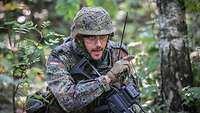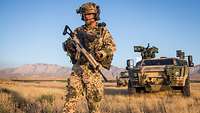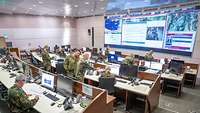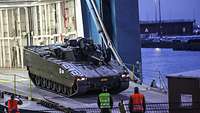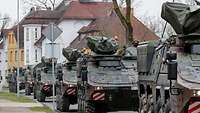Operational Level of Command
Military command and control is carried out at three levels: the strategic, operational and tactical levels. In this respect, the operational level of command is a mediator and translator between the political objectives of the strategic level and the tactical action at the local level.
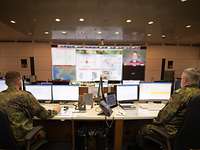
What is the operational level of command?
Military command and control has three levels: the strategic, operational and tactical levels. The strategic level is that of the government, i.e. the Federal Government and the Federal Ministry of Defence, and of Germany’s parliament. These institutions assign tasks to the Bundeswehr, covering the entire operational spectrum of the German armed forces at home and abroad. This ranges from national and collective defence, including measures to deter potential adversaries, military evacuation operations as well as administrative assistance and disaster relief within the constitutional framework through to international crisis management. The political level defines the political objective, while the Federal Ministry of Defence formulates the strategic task.
One level below, the operational level connects strategy and tactics. This is the responsibility of the Bundeswehr Joint Force Command (BwJFCBundeswehr Joint Force Command). The operational level of command formulates the strategic level directives as specific military tasks and creates the framework conditions to enable the subordinate tactical level to fulfil them. The latter comprises the Army, the Navy, the Air Force, and the Cyber and Information Domain Service. At the same time, the operational level of command is required to inform and advise the Federal Ministry of Defence, political representatives and the parliament regularly and whenever needed. In this context, the focus is not only on the implementation but also on the feasibility of the assigned tasks. The operational level of command must also make clear to the political-strategic level which preconditions must be met so that a strategic objective can be achieved.
The tactical level carries out the tasks and is responsible for the employment of its forces. It provides troops and weapon systems, ensures their operational readiness, and accomplishes combat and supply missions, among other things.
Prioritisation: a key task for the operational level of command
The Bundeswehr Joint Force Command assesses tasks at home and abroad and defines the individual tasks for the tactical level, including the special forces. In addition, the operational level determines how the armed services interact, i.e. which command takes on primary responsibility and which command provides support. It allocates forces and capabilities for mission accomplishment, such as airspace surveillance, logistics or medical support.
If resources are limited, the operational level of command must coordinate strategic objectives with the available forces and capabilities so that the required effects can be achieved. This is because, usually, there are several lines of operation running at the same time. Prioritisation is therefore a key task for the operational level of command.
Situation picture as the basis for decisions: up-to-date and comprehensive
The operational level of command must also maintain and continuously update a joint situation picture – 24 hours a day, seven days a week, 365 days a year. An essential part of this situation picture is to document the armed forces’ actual operational effectiveness and combat power as up-to-date as possible. How many soldiers of which units are fully trained, healthy and operational? How many battle tanks are available? How full are the combat aircraft fuel depots? Where on the oceans is which frigate of the Navy?
In addition, a comprehensive civilian situation picture is also maintained. This ranges from the current traffic situation to indications of possible sabotage against critical infrastructure: Which bridges are blocked due to construction work? Which logistics warehouses of civilian companies can be used as rest points for military deployments of own and allied troops? Which ship is sailing on an unusual route near sensitive submarine data cables? Which disinformation campaigns are currently being waged on the internet? In this area, the Bundeswehr Joint Force Command cooperates closely with civilian security authorities and other ministries.
The complete situation picture does not only cover Germany, but all theatres of operations, every mission and every task. Information on areas without current missions can also be incorporated into the situation picture if it is relevant to the tasks of the Bundeswehr Joint Force Command. The situation picture is the prerequisite for the operational level of command to maintain an overview of available and committed resources and capabilities, while at the same time ensuring simultaneous and equivalent accomplishment of parallel missions. Besides the mere provision of information, this always also has a technical dimension: The operational level of command always requires fast and secure transmission of information.
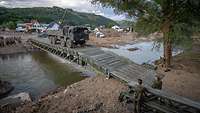
The situation picture covers all operational scenarios of the Bundeswehr, including administrative assistance, as provided following the Ahr valley flood in the summer of 2021.
Bundeswehr/Tom Twardy
Civilian information relevant to military mission accomplishment is also included in the overall situation picture. This also applies to destroyed bridges, such as the Carola Bridge in Dresden.
Bundeswehr/Sven RiedelThe operational level of command explained using a fictitious example
The scenario
A crisis region is shaken by a civil war. Irregular militias stage a coup against the elected government. People are fleeing from combat action. Supply chains are breaking down. Famine looms. In this situation, the United Nations formulate the political and strategic objective of reducing refugee movements and stabilising the affected region. The Bundeswehr is mandated by the Bundestag to accomplish this strategic task as part of an alliance with other nations. The task is provided with a robust mandate. This means that the soldiers of the Bundeswehr will be sent on a military combat mission.
The mission
The Bundeswehr Joint Force Command is tasked with planning and coordinating the operation. This also includes coordination with multinational partners and the armed forces of allied nations. In a first step, the strategic objectives of stabilisation and fighting the causes of flight and migration are converted into operational objectives. One of these could be to fight and eliminate the irregular forces. In addition, refugee camps must be set up and secured in order to mitigate the precarious humanitarian situation of the local population. This includes regular supply convoys to improve the food situation in the region. Another operational objective would be to strengthen the country’s national security institutions so that they can assume responsibility themselves and prevent a resurgence of the conflict.
The planning
At the same time, the operational planning process analyses the forces and assets – personnel, military capabilities and materiel – required to achieve these objectives. This is where the Bundeswehr Joint Force Command (BwJFCBundeswehr Joint Force Command) sets priorities, focuses on available capabilities, and advises the Federal Ministry of Defence concerning resources, time frames and feasibility. This is particularly important if other tasks need to be carried out at the same time, if the Bundeswehr is involved in deterrence measures on NATONorth Atlantic Treaty Organization’s eastern flank, for example, or if it is responding to a natural disaster within the scope of administrative assistance. As the first point of contact for the UNUnited Nations, NATONorth Atlantic Treaty Organization and other multinational actors, the BwJFCBundeswehr Joint Force Command also exchanges information with other armed forces of friendly nations involved in the mission in order to harmonise and coordinate multinational contributions.
Once the framework conditions and operational objectives of the operation have been established, the BwJFCBundeswehr Joint Force Command distributes tasks to the services: It determines who takes primary responsibility and assigns forces and capabilities. During the operation, the operational level of command is responsible for continuously monitoring mission accomplishment and, depending on how a situation develops, for adjusting priorities and reprioritising resources as necessary.
Questions and answers
How does mission command work? What is the difference between tactical, operational and strategic?
You can find answers to these and other questions here:
Operations are military activities that are related in time and space and directed towards a common objective. A distinction is made between military operations on land, at sea, in the air, in the cyber and information space, and special forces operations, which can be carried out across all dimensions.
In addition, military operations are classified according to different characteristics. These may include the force strength – ranging from micro-teams in a cyber operation through to the entire Bundeswehr in a state of defence – or the purpose, for instance a military evacuation. But the terrain – combat in built-up or wooded areas – and the region – the Red Sea, NATONorth Atlantic Treaty Organization’s northern flank, the Sahel – also define the type of military operation.
Another distinguishing feature is the intensity, i.e. the type and degree of military force used in an operation. The intensity varies from low to high, from the mere presence of armed forces for deterrence purposes to high-intensity combat with all available forces defending.
As a general rule, all military operations are conducted at all levels of command – strategic, operational and tactical. Each level has different tasks. The objective of an operation can only be achieved if the different levels of command work together.
In the Bundeswehr, command and control is defined as a process of “guiding and directing aimed at influencing the behaviour of others to achieve a goal”. It involves the planning, control and targeted employment of military forces, weapons, capabilities and information in terms of space and time.
This means that military commanders make decisions based on a comprehensive situation picture derived from the widest possible range of verifiable information from reliable sources. On the basis of this decision, they assign tasks to their subordinate military personnel. At the same time, they create the conditions for these tasks to be fulfilled by setting a realistic objective and assigning the necessary resources. These can include additional military forces, weapon systems, ammunition and supplies, information and, above all, time.
The responsibility of military commanders is indivisible. This applies to all types of command and control – from battle command in infantry combat to staff work at command level – and all levels of command, whether tactical, operational or strategic.
Mission command is a guiding principle of leadership development and civic education in the Bundeswehr. It is firmly anchored at all levels of command, also at the operational level of command.
Mission command simply means: The military commander specifies the “what”, i.e. the objective and framework conditions for reaching the objective, such as time, means and information. The subordinate personnel decides independently on the “how”, i.e. the way to reach the objective. This means that orders often cannot simply be carried out, but that their execution requires discerning obedience and making own decisions. There is thus a fundamental difference between mission command and order-type tactics. In order-type tactics, every single step of a task is predetermined. It is not intended that subordinate military personnel takes independent decisions.
The particular strength of mission command becomes evident during unforeseen events and incidents. Order-type tactics require the subordinate personnel to abort the mission, and the commander to reassess the situation and retask his subordinate personnel. Mission accomplishment is delayed or may become impossible, depending on the dynamics of the ongoing situation. With mission command, the subordinate personnel assesses the situation and decides on an alternative approach to mission accomplishment.
Mission command therefore requires military commanders to be willing to delegate responsibility without ceding overall responsibility. In addition, they must be able to accept that different paths can be taken to reach the same objective. At the same time, the subordinate military personnel must be willing and able to use their permitted scope for action in a targeted and meaningful way to accomplish the mission. Mission command therefore requires a broader range of capabilities and a higher training level than pure order-type tactics.
A strategy is designed for the longer term and sets political or military objectives. The purpose of tactics is to achieve a specific subsidiary objective. In between is the operational level, which translates the strategic objectives into operational objectives, namely into specific actions and effects. It is essential that the tactical level has the necessary means to achieve the defined objectives, i.e. personnel, materiel and supplies.
The following is an example: Two nations get into a border conflict. The strategic objective is to win the conflict and to effectively defend the own territory. For this purpose, air supremacy must be established and maintained over the affected region, among other things. To achieve this operational objective at the tactical level, military action is needed, including air combat, air defence, the bombing of airfields, and the disruption of supply lines. This serves to achieve military effects, such as eliminating enemy air defence, destroying enemy combat aircraft, or interrupting the supply of fuel and spare parts. At the same time, the army conducts land operations to destroy enemy forces and prevent them from gaining territory. Accordingly, several tactical objectives lead to the achievement of one operational objective, and several operational objectives lead to the achievement of the overall strategic objective.
Broadly speaking, the operational level of command creates the conditions to enable the tactical level of command to accomplish its tasks. For this purpose, the operational level of command translates the directives of the strategic level of command into specific individual tasks. It also assigns the military forces and capabilities required for mission accomplishment. The tactical level ensures operational readiness and carries out the individual tasks.
In the Bundeswehr, the Bundeswehr Joint Force Command (DEU JFCJoint Force Command) holds responsibility for the operational level of command concerning all tasks, operations and missions throughout the entire operational spectrum of the armed forces. The DEU JFCJoint Force Command, stationed in Berlin and Schwielowsee, is responsible for national and joint planning, conduct and evaluation of operations.
The Federal Ministry of Defence, as the requesting entity of the armed forces, represents the strategic level of command. The ministry is assigned tasks by the political level: the German government and the German Bundestag. Depending on the mission, the tactical level of command is carried out by the armed services, i.e. by the Army, Navy, Air Force and Cyber and Information Domain Service, and by the Bundeswehr Joint Support Command Headquarters for purely medical missions.
In short, this means the strategic level decides on the operation as such and approves the forces required to achieve the objective. The operational level commits the forces and creates the framework conditions for their deployment. The tactical level then uses the forces to achieve military-tactical objectives.


